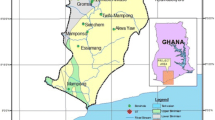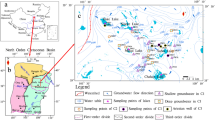Abstract
The study of groundwater recharge and of flow systems is crucial to understand availability and sustainability of groundwater resources. This study uses hierarchical cluster analysis (HCA) and various graphical plots of hydrochemical and isotopic data to examine groundwater recharge and the dynamics of flow system in the Dawa River basin. HCA has classified the water samples into five distinctive clusters. Clusters I, II, and III represent the volcanic and most parts of the basement terrain. These clusters are distinguished by low EC, high percentages of HCO3 − and Ca2+, Mg2+, or Na+, and dominantly (Ca, Mg, Na, K)–HCO3-type water. Cluster IV contains sulfate-type water with high percentage of Ca2+ + Mg2+ and represents sedimentary terrain. Cluster V, characterized by high EC and abundant Na+ and SO4 2− + Cl−, is sited at few locations along dry riverbeds. In the basement terrain, the chemical composition of groundwater varies greatly over short distances. In most parts of the basin, groundwater contains elevated levels of tritium at amount comparable to local rainfall. These chemical characteristics supported with tritium data indicate the dominance of groundwater of local flow systems, short residence time, and modern recharge in the basin. Stable isotope data indicate that in the semi-arid region, recharge occurs from high-intensity rainfall. Difference in δ18O and δ2H between the northern and the southern and southeastern groundwater supports distinct recharge sources and the absence of regional groundwater flow between the two regions. Converging evidences reveal that the traditional regional groundwater flow model which is common in most large river basins of Ethiopia does not hold true in the Dawa River basin.








Similar content being viewed by others
References
Abdelsalam MG, Stern RJ (1996) Sutures and shear zones in Arabian–Nubian shield. J Afr Earth Sci 23(3):289–310
Adams S, Titus R, Pietersen K, Tredoux G, Harris C (2001) Hydrochemical characteristics of aquifers near Sutherland in the Western Karoo, South Africa. J Hydrol 241:81–93
Assefa G (1988) Potential hydrocarbon-generating rock units within the Phanerozoic sequence of the Ogaden basin, Ethiopia: a preliminary assessment using the LOPATIN model. J Pet Geol 11(4):461–472
Back W (1966) Hydrochemical facies and groundwater flow patterns in northern part of Atlantic Coastal Plain. United States Geological Survey professional paper 498-A
Belete Y, Abaire B, Asfaw B, Tigabe M, Shiferaw D, Belachew A, Abdela M (2000) Hydrogeological, geophysical, and engineering geological investigation of Yabelo sheet (NB 37-14). Institute of Geological survey of Ethiopia, Addis Ababa
Belkhiri L, Boudoukha A, Mouni L, Baouz T (2010) Application of multivariate statistical methods and inverse geochemical modeling for characterization of groundwater—a case study: Ain Azel plain (Algeria). Geoderma 159:390–399
Bisson RA, Lehr JH (2004) Modern groundwater exploration: discovering new water resources in consolidated rocks using innovative hydrogeologic concepts, exploration, drilling, aquifer testing, and management methods. Wiley, New Jersey
Bugliosi EF (1999) The Midwestern Basins and Arches regional aquifer system in parts of Indiana, Ohio, Michigan, and Illinois. U.S. Geological Survey Professional Paper 1423-A
Chebotarev II (1955) Metamorphism of natural waters in the crust of weathering. Geochim 8:22–28
Dalton MG, Upchurch SB (1978) Interpretation of hydrochemical facies by factor analysis. Groundwater 16(4):228–233
Danskin WR (1998) Evaluation of the hydrologic system and selected water-management alternatives in the Owens, Valley, California. U.S. Geological Survey Water supply Paper 2370-H
Davis SD, Whittemore DO, Fabryka-Martin J (1998) Uses of chloride/bromide ratios in studies of potable water. Groundwater 36(2):338–350
Demlie M, Wohnlich S, Wisotzky F, Gizaw B (2007) Groundwater recharge, flow, and hydrogeochemical evolution in a complex volcanic aquifer system, central Ethiopia. Hydrogeol J 15:1169–1181
Deyassa G, Kebede S, Ayenew T, Kidane T (2014) Crystalline basement aquifers of Ethiopia: Their genesis, classification, and aquifer properties. J Afr Earth Sci 100(2014):191–202
Furlong BV, Riley MS, Herbert AW, Ingram JA, Mackay R, Tellam JH (2011) Using regional groundwater flow models for prediction of regional well water quality distributions. J Hydrol 398(1–2):1–16
Gat JR (2010) Isotope hydrology: a study of water cycle. Imperial College, London
Gamachu D (1977) Aspects of climate and water budget in Ethiopia. Addis Ababa University Press, Addis Ababa
Glynn PD, Plummer LN (2005) Geochemistry and the understanding of ground-water systems. Hydrogeol J 13:263–287
Güler C, Thyne GD, McCray JE, Turner AK (2002) Evaluation of graphical and multivariate statistical methods for classification of water chemistry data. Hydrogeol J 10:455–475
Hamrla M (1977) The Adola gold field, Ethiopia: geology and genetic hypothesis. Geologija 20:247–282
Heath RC (1983) Basic groundwater hydrology. USGS water supply paper 220
http://www.iaea.org/water. Accessed on 04 December 2013
Hunegnaw A, Sage L, Gonnard R (1998) Hydrocarbon potential of the intracratonic Ogaden Basin, Southeast Ethiopia. J Pet Geol 21(4):40–425
Kebede S (2013) Groundwater in Ethiopia: features, numbers, and opportunities. Springer, Berlin
Kebede S, Travi Y, Alemayehu T, Ayenew T (2005) Groundwater recharge, circulation and geochemical evolution in the source region of the Blue Nile River, Ethiopia. Appl Geochem 20(2005):1658–1676
Kebede S, Travi Y, Asrat A, Alemayehu T, Ayenew T, Tessema Z (2007) Groundwater origin and flow along selected transects in Ethiopian rift volcanic aquifers. Hydrogeol J. doi:10.1007/s10040-007-0210-0
Kozyrev V, Kebede G, Safonov J, Tullankin V, Woldemichael B (1982) Geological map of the Adola area. Institute of Geological Survey of Ethiopia, Addis Ababa
Kroner A, Stern RJ (2004) Pan-African Orogeny. Encycl Geol 1:1–12
Leibundgut C, Maloszewski P, Kulls C (2009) Tracers in hydrology. Wiley, Atrium
Mohr P, Zanettin B (1988) The ethiopian flood basalt province. Continental Flood Basalts. Kluwer Academic Publishers, London, pp 63–110
MoWIE (2007) Genale-Dawa river basin integrated resources development master plan. Minstry of Water Resources and Energy, Addis Ababa
Ophori DU, Toth J (1989) Patterns of groundwater chemistry, Ross Creek Basin, Alberta, Canada. Groundwater 27(1):20–26
Piper AM (1944) A graphic procedure in the geochemical interpretation of water analysis. Trans Am Geophys Union 25:914–923
StatSoft Inc (2007) Statistica (Data analysis software system), Version 8.0. www.statsoft.com
Todd DK, Mays LW (2004) Groundwater hydrology. Wiley, Hoboken
Toth J (1984) The role of regional gravity flow in the chemical and thermal evolution of groundwater. First Canadian/American conference on Hydroggeology, Banff, Alberta. Memoir No. 8
Tóth J (1963) A theoretical analysis of groundwater flow in small drainage basins. J Geophys Res 68:298–315
Walton NRG (1989) Electrical conductivity and total dissolved solids—What is their precise relationship? Desalination 72(3):275–292. doi:10.1016/0011-9164(89)80012-8
Waterloo Hydrogeologic Inc (2003) AquaChem (Chemical Analysis Software), version 4.0.284. http://www.waterloohydrogeologic.com
Woldehaimanot B, Behrmann JH (1995) A study of metabasite and metagranite chemistry in the Adola region (south Ethiopia): implications for the evolution of the East African Orogeny. J Afr Earth Sci 21(3):459–476
Worku H (1996) Geodynamic development of the Adola Belt (southern Ethiopia) in the Neoproterozoic and its control on gold mineralization. Ph.D. Dissertation, Berlin Technical University
Worku H, Schandelmeier H (1996) Tectonic evolution of the Neoproterozoic Adola Belt of southern Ethiopia: evidence for Wilson Cycle process and implications for oblique plate collision. Precambr Res 77:179–210
Yibas B, Reimold WU, Armstrong R, Koeberl C, Anhaeusser CR, Phillips D (2002) The tectonostratigraphy, granitoid geochronology and geological evolution of the Precambrian of southern Ethiopia. J Afr Earth Sci 34(2002):57–84
Zewdie G, Nahusenay B (2011) Hydrogeological and hydrochemical mapping of Sede map sheet (NB 37-16). Institute of Geological Survey of Ethiopia, Addis Ababa
Zewdie G, Sima J (2011) Explanatory notes to hydrogeology and hydrochemichal maps of Negele sheet, NB 37-11. AQUATEST, Prague
Zhou Y, Li W (2011) A review of regional groundwater flow modeling. Geosci Front 2(2):205–214
Zouari K, Trabelsi R, Chkir N (2011) Using geochemical indicators to investigate groundwater mixing and residence time in the aquifer system of Djeffara of Medenine (southeastern Tunisia). Hydrogeol J 19:209–219
Acknowledgments
The authors are grateful to School of Earth Sciences, Addis Ababa University, for the support of field work and laboratory facility. The contribution of Guji and Borana Zone water resources office for the success of field work is also appreciative. Thanks to National Meteorological Agency for the provision of climatic data. Thanks to Dagimawi, Adane, and Dr. Nicolo for the assistance in analyzing hydrochemical and isotope samples. Special thanks also go to Uraga, Gumi, Satana, Adan, and Abdulshikur for the support during field activity.
Author information
Authors and Affiliations
Corresponding author
Rights and permissions
About this article
Cite this article
Woldemariyam, F., Ayenew, T. Application of hydrochemical and isotopic techniques to understand groundwater recharge and flow systems in the Dawa River basin, southern Ethiopia. Environ Earth Sci 75, 1002 (2016). https://doi.org/10.1007/s12665-016-5777-0
Received:
Accepted:
Published:
DOI: https://doi.org/10.1007/s12665-016-5777-0




